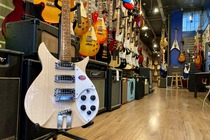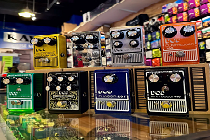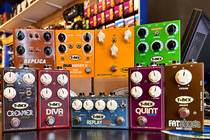Those new to playing guitar are often, quite rightly, overwhelmed by the sheer selection of guitar strings when it comes time to re-stringing their instrument. This confusion isn't restricted to new guitar players - even experienced players are confronted by dozens of new models reporting to be the 'next big thing'.
The reality is, there are only really three things to seriously consider when choosing your new set of strings. Hopefully, the following will de-mystify the process, once and for all.
The first consideration, which may seem very obvious to some, but it really isn't if you're new to guitar, is what type of guitar you have. Electric steel strings on electric guitars, steel acoustic strings on acoustic guitars, and nylon strings on classical guitars. Rule of thumb, strings are not interchangeable between different types of guitar, by which I mean, you shouldn't really put electric strings on an acoustic guitar, and certainly not put steel strings of any type on a classical guitar. All guitars are built with certain strings in mind, both for tone and structural integrity of the instrument. At best (say, putting electric strings on an acoustic) the guitar will sound weak and lacking in volume. At worst (say, putting steel strings on a classical guitar) will cause major structural problems. Stick to the right TYPE of string, and you won't go far wrong.
The second consideration is gauge (as in 'page'). Gauge is the thickness of the string in millimeters. Gauges will most commonly be expressed by the thickness of the thinnest string (so you might hear someone say "Can I have a pack of 10s please?", meaning strings where the top string is 0.010mm thick). Sometimes people might say "10 to 46s", which just means 0.010mm on the thinnest string, and 0.046mm on the thickest string. In general, gauges are standardised, so all packs of '10s' will have a 46 on the bottom (thickest) string, but there are some hybrid or custom sets available for those wanting a different combination of thicknesses. The thicker the gauge, the 'stiffer' it will feel, but the more 'full' a tone you will get, so choosing the right gauge for you is a trade-off between the two. Classical strings come in different tensions, but in essence, the tensions come from the different thicknesses, so the principle is the same.
The third and final consideration is the materials used. With acoustic strings, the two most common are 80/20 bronze and phosphor bronze. The latter is usually more expensive, but has a 'fuller', louder tone. Electric strings can be a minefield, but the majority are steel core, nickel coated. Some, such as Elixir, will have a nanoweb coating which extends string life - useful for those who play every day, gig a lot, or have excessively sweaty hands. There are several others, such as Ernie Ball Cobalt strings, which use the more magnetic cobalt to produce a higher pre-amplified output.
The bottom line to all of this is two-fold. First, never be afraid to ask for advice. Second, try as many as you can to begin with, find the ones you like the best, and stick to those.
Until next time, TECH care of yourselves, and your guitars. Ed.










